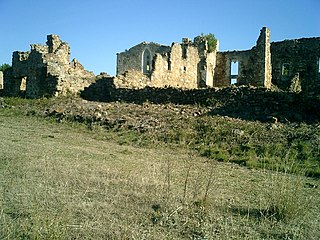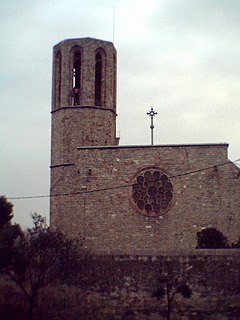 W
WThe monastery of Santa María del Roure, referred to as El Roure by locals, is a ruined monastery to the northwest of Pont de Molins at the top of the Sierra de los Tramonts. Mostly Gothic-era portions of the building are preserved. Dedicated to the Virgin Mary, the various names of the sanctuary -Santa María del Roure, Canónica de Santa María del Roure, Monastery of Santa María del Roure, or according to the Cartographic Institute of Catalonia: Mare de Deu del Roure- date from the 11th or early 12th century. This building is indexed in the Catalan heritage register as Bé Cultural d'Interès Local (BCIL) under the reference IPA-19985.
 W
WThe Monastery of Pedralbes is a Gothic monastery in Barcelona, Catalonia, Spain. It is now a museum, housing permanent exhibitions on its own art and legacy as well as third-party special exhibitions from time to time. The Chapel of St. Michael was restored and re-opened in 2018.
 W
WPoblet Abbey, otherwise the Royal Abbey of Santa Maria de Poblet, is a Cistercian monastery, founded in 1151, located at the foot of the Prades Mountains, in the comarca of Conca de Barberà, in Catalonia (Spain). It was founded by Cistercian monks from France on lands conquered from the Moors. The main architect was Arnau Bargués.
 W
WSant Pau del Camp is a church and former monastery in Barcelona, Catalonia, Spain. While the monastery now stands within the El Raval district in central Barcelona, it once stood outside the city ; its rural location gave the church its name.
 W
WThe Monastery of Sant Joan de les Abadesses is a monastery in the comarca of Ripollès, Catalonia, northern Spain. Until the year 945 it was the only female monastery in the area.
 W
WThe Sant Cugat Museum was opened on 23 April 2003; its mission was to oversee the conservation and dissemination of the historic, artistic and cultural heritage of Sant Cugat del Vallès in Catalonia. It is part of the Barcelona Provincial Council Local Museum Network and has two centres: the Sant Cugat Monastery and Casa Aymat plus two other buildings, the Celler Modernista and the Chapel of Sant Domenec. In both areas there are spaces reserved for temporary exhibitions related to art, history and local and universal heritage. In addition, the Museum works to recover the heritage and memory of the town, periodically organising walks that help people discover local history and heritage.
 W
WThe Monastery of Santa Maria de Santes Creus, is a former Cistercian monastery in the municipality of Aiguamúrcia, Catalonia, Spain. The abbey was erected in the 12th century, in today's municipality of Aiguamurcia, in the village of Santes Creus, in the province of Tarragona (Catalonia). However, it was in the thirteenth century when Peter III of Aragon expressed his desire to be buried in the monastery and a royal crypt was built for himself and his son, King James II that many of the local nobility established the custom to choose this place for burial. This led to the monastery to increase in splendor and greatness thanks to the numerous donations received.
 W
WVallbona Abbey, otherwise the Monastery of Santa Maria de Vallbona, is a Cistercian nunnery in Vallbona de les Monges, in the comarca of Urgell, Catalonia, Spain. Founded in the early 12th century, and built between then and the 14th century, it is one of the most important monastic sites in Catalonia. Its church represents an example of transition between Romanesque and Gothic architecture. The abbey was declared a national monument on 3 June 1931.